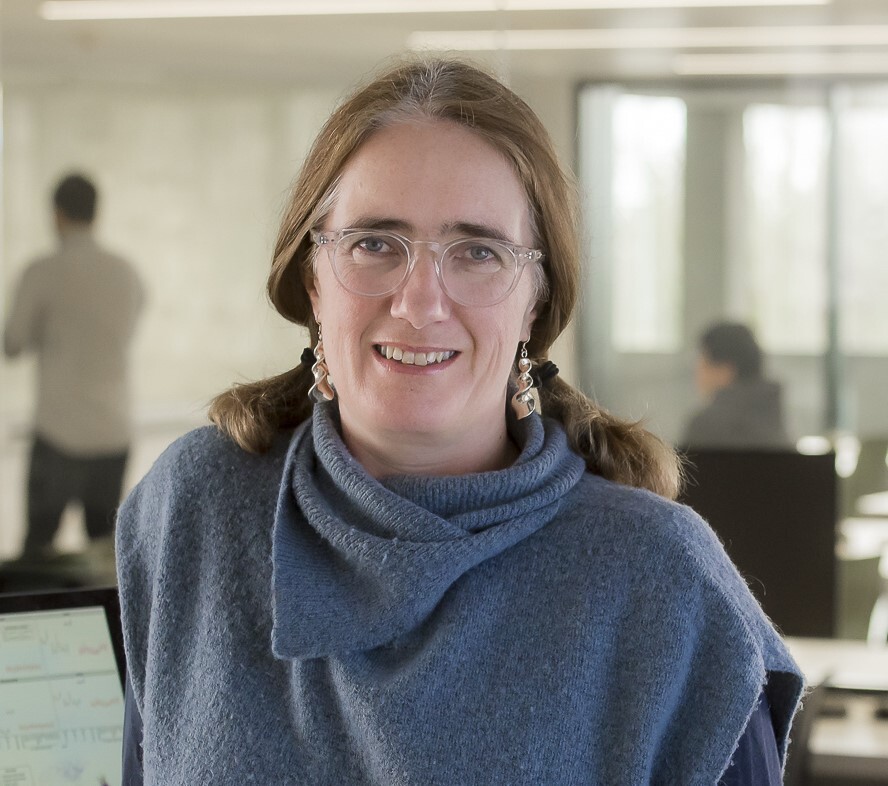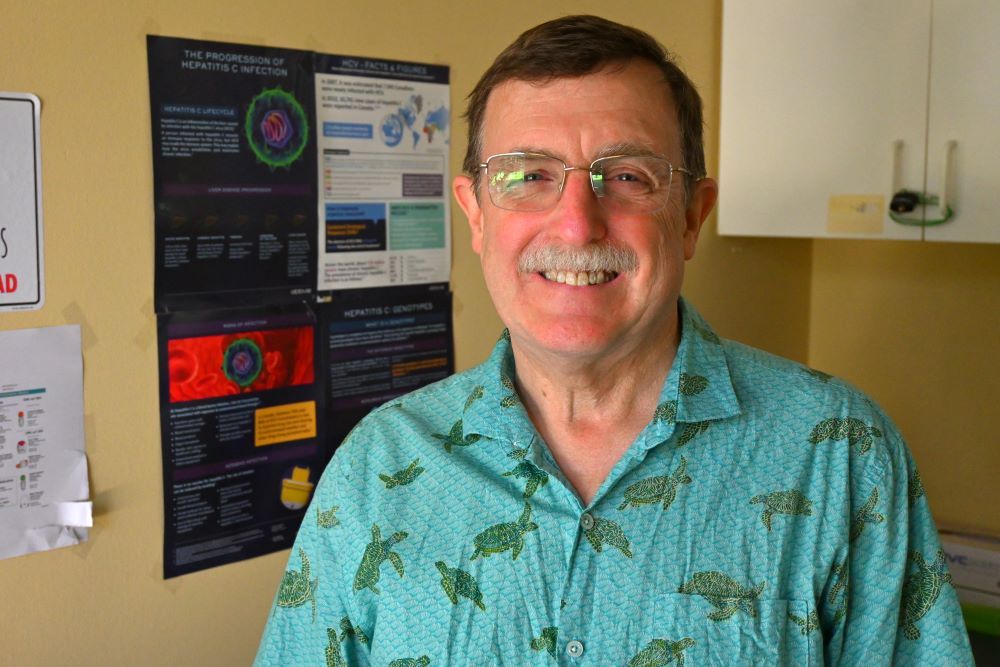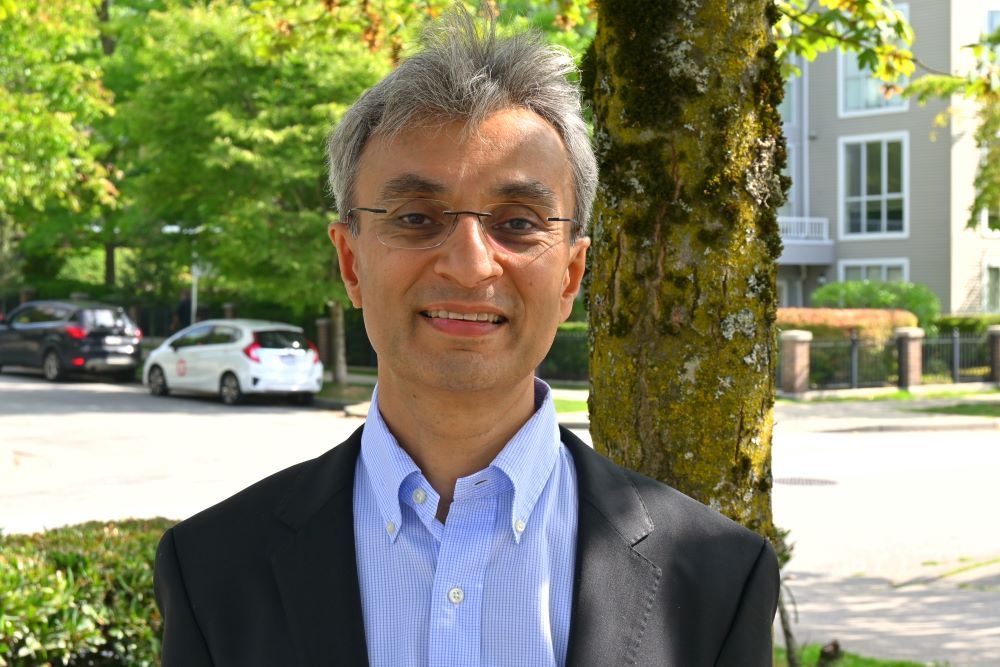Articles Menu

Sept. 25, 2023
Earlier this year the COVID-19 pandemic was downgraded from an emergency to an endemic disease, meaning society would have to learn to live with the risk.
But that’s not to say the risk is gone, health experts told The Tyee. It’s better to think of it like the risk of a car crash or, in other parts of the world, like malaria — in other words, still a relatively high risk, and one you should be taking precautions to avoid.
To chew over how to best navigate this new COVID era, The Tyee invited three health experts to join a facilitated debate to discuss pandemic policy and ask how B.C. could better approach the no-longer-novel coronavirus.
Caroline Colijn is a mathematician and infectious disease modeller at Simon Fraser University. She holds a Canada 150 Research Chair in mathematics for evolution, infection and public health and has worked on COVID modelling and forecasting throughout the pandemic.
Sanjiv Gandhi worked as head of pediatric cardiothoracic surgery at BC Children’s Hospital and is a clinical professor of surgery at the University of British Columbia. He recently left medicine to run for office with the BC Green Party.
Dr. Brian Conway is medical director of the Vancouver Infectious Diseases Centre.
The Health Ministry was also invited to join the discussion but declined.
The interview has been edited for length and clarity.
The Tyee: Let’s start with public messaging about COVID-19. Should we be asking for more updates from the Health Ministry?
Caroline Colijn: We need to be continuing the public conversation. This is not just an acute illness that will make you miss work and school or lead to hospitalization and the ICU. We now know the virus can cause longer-term impacts like long COVID. Those risks are small but when you aggregate them across a lot of infections and lots of people, you’re looking at increases in cardiovascular disease, inflammatory diseases and other problems. So we do need a public conversation about how the virus continues to evolve and what the real risks are — not just in the short term but for our long-term health.
Sanjiv Gandhi: One of my biggest beefs with public health has been that not every study needs to be shared. The nuances of Caroline’s mathematical modelling don’t need to be shared. But the public does need to be educated and that’s public health’s job. If we’re asking people to assess their own risks, they need to understand the virus is transmitted through the respiratory system by airborne measures so it can travel around corners and stay in the air.
Long-term health impacts of viruses is nothing new to public health. HIV doesn’t cause problems right away but later, when your immune system is depressed. Same with tuberculosis, which attacks the whole body. The average joe doesn’t understand this. They think, “I got the sniffles and a cough for a couple of days and then it went away.” We are worried about the number of people who have repeat infections. The cumulative number of people who might suffer from these health effects later on is going to be immense.
Colijn: Other respiratory viruses can have long-term consequences, including influenza, but you don’t expect to get infected with influenza once or twice a year, more like every five years. There are communities that suffer disproportionately high COVID infection rates who now suffer a disproportionate burden of future health risks. There’s inequitable consequences.
The Health Ministry told The Tyee “there is no evidence that implementing a mask mandate in schools will reduce the spread of COVID-19, influenza, or RSV.” One local study says school isn’t where kids are getting sick, but other studies say the majority of U.S. households were infected by a young family member. What do you think, should we bring back school mask mandates?
Gandhi: Because of the way this was handled at the start of the pandemic, masks became the hottest political issue around the pandemic. They should have been introduced as a protective measure, like a seatbelt or bike helmet, not a restrictive measure. There was some racialization too because masks were not part of “our” culture.
Because of their politicization it’s going to be extremely difficult to reintroduce them in a school environment. Bringing them back to health care is a no-brainer but schools will be more difficult.
That’s where public education comes into play. If the public understood the long-term ramifications of the virus, and we actually measured air quality in classrooms with carbon dioxide monitors, parents would be better equipped. I’ve spoken with a boatload of parents whose kids are already home sick and school just started.

Colijn: It’s easy to measure if masks protect an individual but harder to measure how masks protect the people around them. These differences muddy the waters for data on masking.
But there is still ample data. For example, Alberta schools without mask mandates had three times more outbreaks than those with mandates. There’s a lot of other examples.
We use stop signs, seatbelts and helmets. We know these don’t prevent all car accidents or all instances of speeding. But they’re part of the public conversation around risk. We need to educate people so they can fully understand the risks of COVID and then make informed decisions.
The public are no dopes. They can follow complex information. I mean, people follow American football and complex storylines in TV shows. They understand there isn’t a silver bullet with vaccines, masks or clean air. It’s all the Swiss cheese metaphor.
Brian Conway: Even at the peak of the pandemic, public grade schools were among the safest environments for children because we knew who was coming and going and could isolate cases. I’m not aware of evidence that school environments amplified transmission. Schools were at or below levels of community transmission.
I’m disappointed we haven’t vaccinated more children or adolescents. Vaccinations are our first line of defence. Let’s vaccinate people and keep sick people out of schools. If we do that, I think we’ll do very well. Keep washing our hands too. Masks are another layer of defence but I’m not seeing a mask mandate in schools as necessary right now.
Gandhi: Dr. Conway has a lot more infectious disease experience than I do, but I’ve worked with kids for 30 years and they’re great vectors for transmission of airborne diseases. As I outlined, I don’t think masks are going to be something we can implement, but the public needs to be educated more on how this disease is spread.
I agree vaccinations are incredibly important and that uptake in B.C. has been horrible, especially for children, and we can improve that. But I also don’t think vaccinations are the panacea like we thought they’d be at the start of the pandemic. They clearly don’t prevent transmission but do reduce severity, hospitalization, death. But they don’t prevent you from getting COVID over and over. And multiple infections contribute to the systemic manifestations of the disease down the line.
Public health has said they don’t want to roll out vaccines in schools because parents want to be with their children. I don’t get that at all. Vaccine uptake has been horrible and expecting different results by doing the same thing doesn’t seem to be a prudent tactic going forward.
Vaccines are not the be-all end-all but they are incredibly important. We should be rolling them out in schools if we want more kids to get vaccinated.
Colijn: Vaccines do prevent some transmission and infection to some extent but nothing like what you see with other childhood immunization programs like measles. We shouldn’t throw it away even now with Omicron where there’s 30 to 50 per cent effectiveness there.
That said, I haven’t seen data about new vaccines or boosters.
There is vaccine fatigue but there also hasn’t been much noise about the importance of staying up to date with your boosters or getting the new fall vaccine. We’re already seeing a rise in hospitalizations in the U.S. with schools having started in July. We need to urgently be rolling out vaccines if we want to use them as a tool for this fall surge.
Gandhi: Health Canada approved the Moderna vaccine Sept. 12. Moderna and Pfizer have been approved by the FDA in the U.S. Dr. Theresa Tam was on TV saying she hopes for a vaccine rollout in October.
My fear is that it’s early September and by mid-October infection rates will have gone up significantly. So I’m worried.
If I was king I would have had everybody get their boosters in the summertime so they’d have three months between the boosters and the new vaccine. There’s very few people who are more than six months out from their most recent vaccination and/or COVID infection.
Conway: We need the health authorities to launch the broadest, most open vaccination program that can exist. I think for adults this time there won’t be registration; it’ll be just like getting your flu shot where you walk into a pharmacy. You could get it at the same time as the flu shot.
This is an amazing opportunity for schools. The reason the human papillomavirus vaccine gets such high uptake is that in Grade 6 the schools just do it. Parents can still refuse. We could do the same with COVID vaccines, just choose a day and do it.
If you spoke to the average joe on the street, how many people would tell you that COVID is gone? It’s a big number who would tell you it’s finished.
I’ve been counteracting that sentiment with ‘You know, the flu pandemic occurred in 1918 and we’re still giving shots. So get used to it every year.’ Normalizing it will help a lot.
Any other ways we could boost childhood vaccination rates?
Gandhi: Educating parents about the consequences of COVID. This is not the flu or a cold. It has long-term ramifications if your kid gets infected over and over again. You need to do whatever you can to prevent that. The whole hybrid immunity thing is not something you want to actively get. We don’t ask people to get infected with HIV over and over again. We don’t do that with any other disease in medicine.
Conway: We need to get adults more interested in getting the vaccine. The medical field has stopped using the word “booster” because this is “just the next one.” We could give the COVID and flu shot at the same time. Actually by 2024 there will be a combined COVID-flu shot. Like how you get vaccinated for measles, mumps and rubella in one vaccine.
COVID is endemic. We need to plan as a society how we will deal with it from cradle to grave. Vaccines are normal; we need to get that message through.

Colijn: I think there’s also an anti-vax sentiment in keeping COVID vaccines out of schools. It’s fine for HPV and other childhood immunizations we do routinely, but this one is somehow “not routine.” This feeds into online misinformation about this vaccination being scary.
Gandhi: This mRNA vaccine is one of the safest vaccines mankind has ever encountered. There’s no dead virus or live virus. It’s an antigen that we’re presenting and it’s revolutionized the vaccine world.
Do you think we’ll look back at this time as post-COVID in any way, now that it’s endemic?
Colijn: Endemic means we’re used to it, not that it’s fine. Malaria and the flu are endemic but that doesn’t mean they’re fine.
COVID will be with us constantly, not seasonally like the flu or regionally like malaria.
I’m not sure if we’ll see this as a post-pandemic era but maybe we will look back and say, ‘That’s when we started being used to it.’
The virus will continue to evolve, sure as gravity will keep your coffee mug stuck to your desk. We knew in 2021 if we vaccinated large numbers of people, we’d create conditions that favoured immune escape variants of this virus. Several months after that, Omicron emerged and was very effective at spreading throughout the world and was less lethal than previous variants.
Evolution could bring us a more lethal variant. Or it could bring us a variant that’s been spreading through animals or other host populations, or other evolutionary surprises. Or it could bring us a variant that is more mild.
Probably we’ll look back at this time as “post-acute COVID” but it’s not yet in a mode where it’s predictably seasonal.
One thing we can confidently predict is that evolution will continue to bring us new viruses and new forms of this virus.

Have we learned anything from this pandemic? Any ways we’ve changed or revamped society?
Gandhi: No, absolutely not. Indoor air quality should have been completely altered based on COVID and wildfires but it’s become another divisive thing.
The only thing I know for certain is there’s going to be another pandemic, whether next year, 10 years from now or after everyone in this conversation is dead.
Colijn: Thanks to public health initiatives we no longer smoke indoors, drink and drive or drive without seatbelts. We no longer tell people who are worried about gastrointestinal diseases to boil their water, even though that shift took years even after John Snow’s first observations about cholera.
I hope it doesn’t take years to think about all the benefits of cleaner indoor air. The next pandemic might not be airborne or it might be another coronavirus with a fatality more like MERS or SARS. It’s very hard to predict.
In the past few decades we’ve seen SARS, Ebola, Zika, H1N1 — there’s been a lot in the past 20 years as we have increased density, climate change and other vectors that bring us into more contact with animals, mosquitoes and ticks, potentially bringing us into more contact with other viruses.
I hope we can learn lessons about infectious disease surveillance, data sharing, global collaboration, global vaccine equity and equitable access to new therapeutics and vaccines.
Conway: Bottles of hand sanitizer! Washing our hands needs to become really normal because touching your face and then shaking someone’s hand is a recognized mode of transmission for a number of different pathogens.
I agree clean air quality also needs to be normalized but it’s a bigger hill to climb.
A high-level lesson we’ve learned is if you’re sick, don’t take a pill and drag yourself in. But it’s nowhere near universal. Sick people staying home needs to be a lesson learned from this pandemic.
In many parts of B.C. it is possible to leave a window open year-round to make sure you’ve got good indoor air circulation.
Gandhi: I bought a CO2 monitor from Amazon for $49 and take it with me wherever I go to measure air ventilation. When you can’t open windows or if it’s too cold out, you can use a HEPA air filter, which cost around $129, or you can build one. They’re effective at cleaning the air.
Conway: When I was much younger I’d work with children infected with bacterial meningitis, which was fatal in some cases. It was common and very dangerous. Now it’s almost never seen because of vaccination.
Vaccines as a tool are very powerful. We know COVID vaccinations prevent 50 per cent of what we’re now calling post-COVID condition, which was previously long COVID. The American Medical Association said post-COVID conditions have cost the world economy $2.6 trillion. With more vaccinations we could have cut that number in half. We need people to roll up their sleeves and get their shots.
Gandhi: You should say “roll up your sleeves and roll down the windows.”
Conway: Yes, let’s make that the new saying!
Final question. The Health Ministry says it’s moving away from PCR tests and instead focusing on distributing rapid antigen tests. Do we still need PCRs?
Gandhi: The whole “don’t test, don’t tell” thing is wrong. We should be tracking the incidence and prevalence of this disease. PCR tests were eliminated because of cost, but [rapid antigen tests] are not nearly as good. You need to do them two to three times to make sure, and even then you can get a false negative.
At the same time I’m encouraging everyone to stock up on RATs and use them whenever they feel they need to.
Colijn: Doing PCR tests on everyone who has respiratory symptoms is not feasible, and RATs do have a role to play but they shouldn’t be used as a medical diagnostic.
I’d like to see random samples of the population tested so we can better interpret wastewater, deaths and hospitalizations. We could test a different 3,000 people every week as a representation of the population. From a data point of view, that would be incredibly valuable to understand prevalence and incidence of this infection.
Michelle Gamage is The Tyee’s health reporter. This reporting beat is made possible by the Local Journalism Initiative.
[Top photo: ‘Because of the way this was handled at the start of the pandemic, masks became the hottest political issue around the pandemic. They should have been introduced as a protective measure, like a seatbelt or bike helmet, not a restrictive measure,’ says Dr. Sanjiv Gandhi. Photo via Shutterstock.]